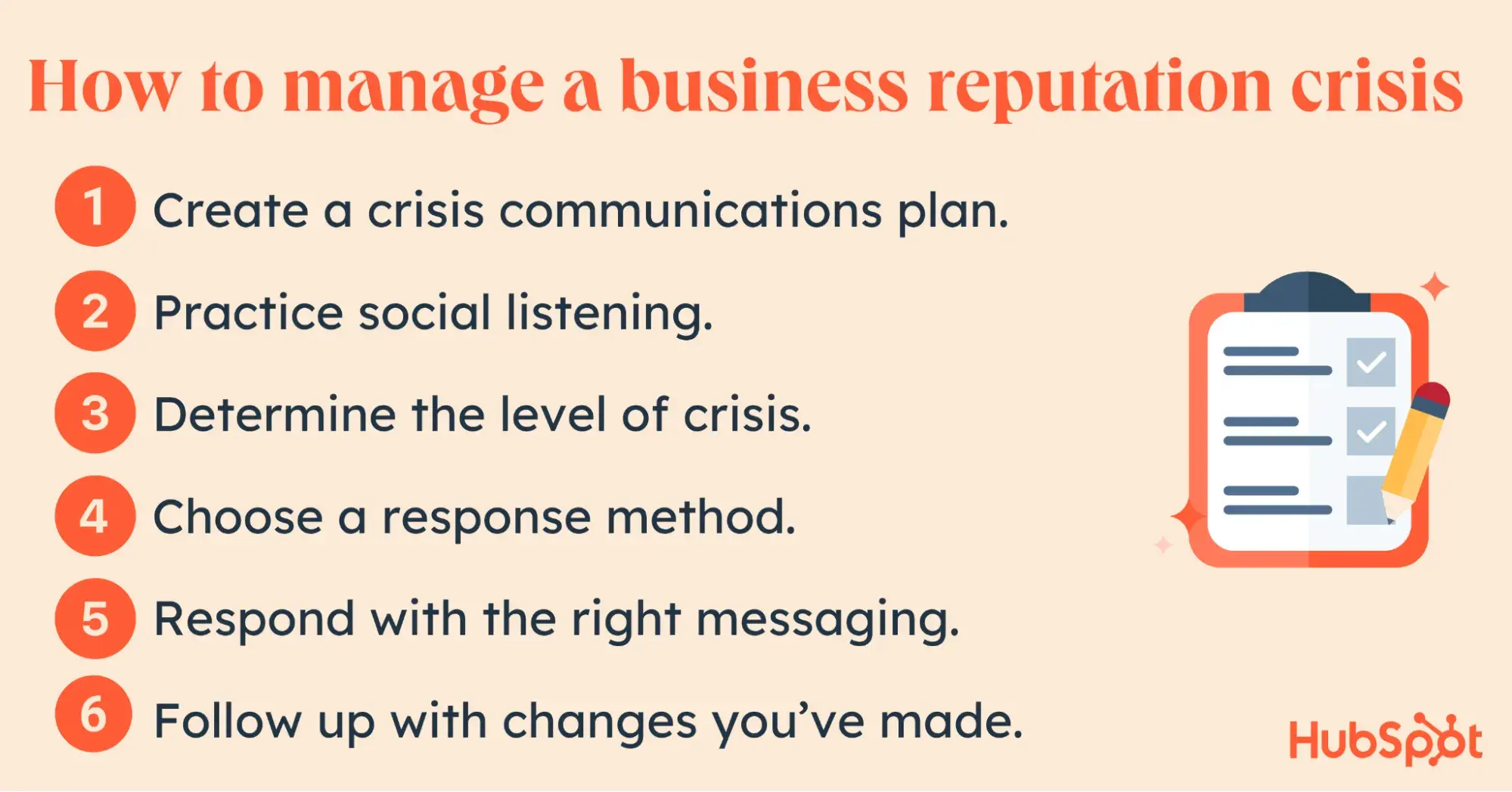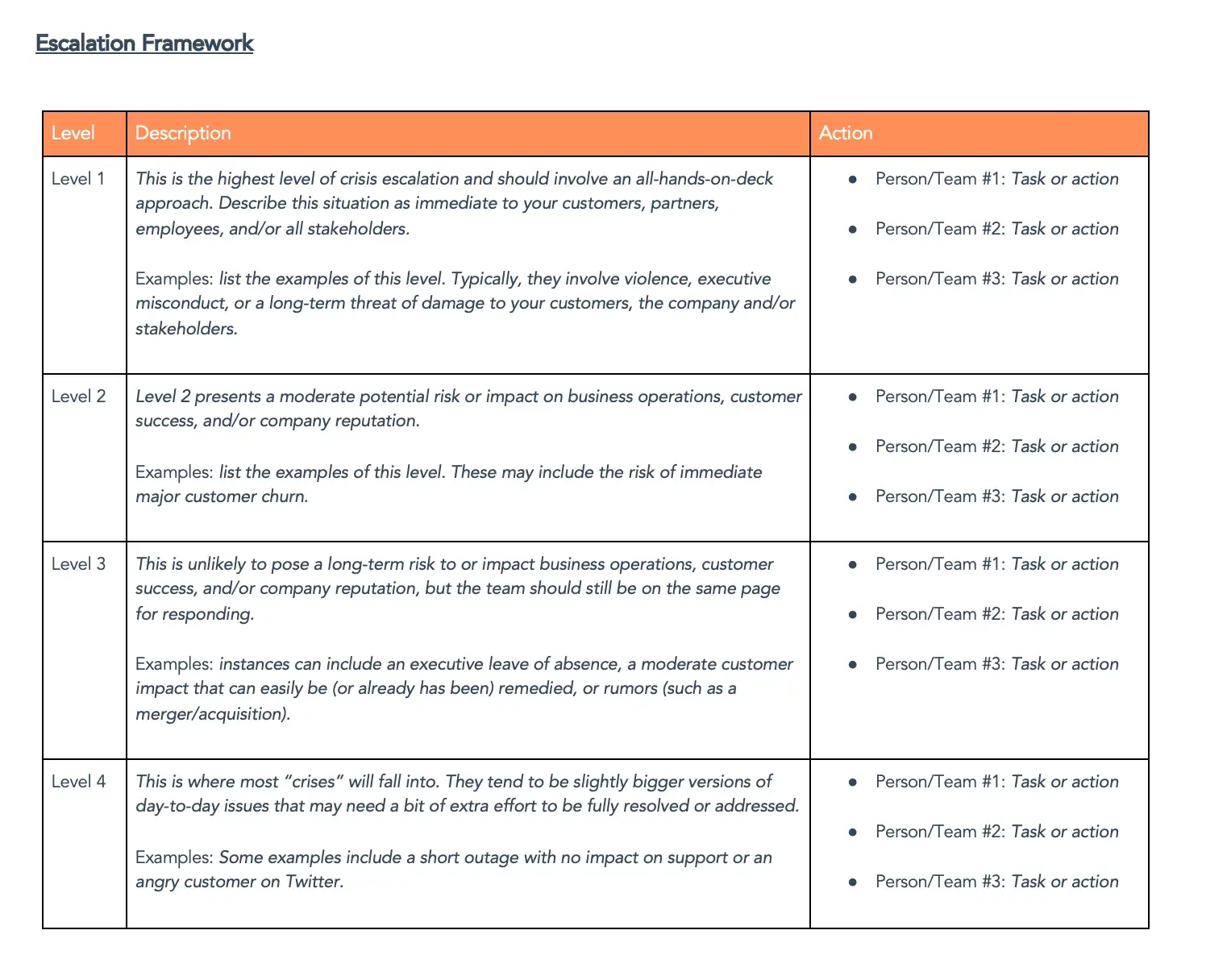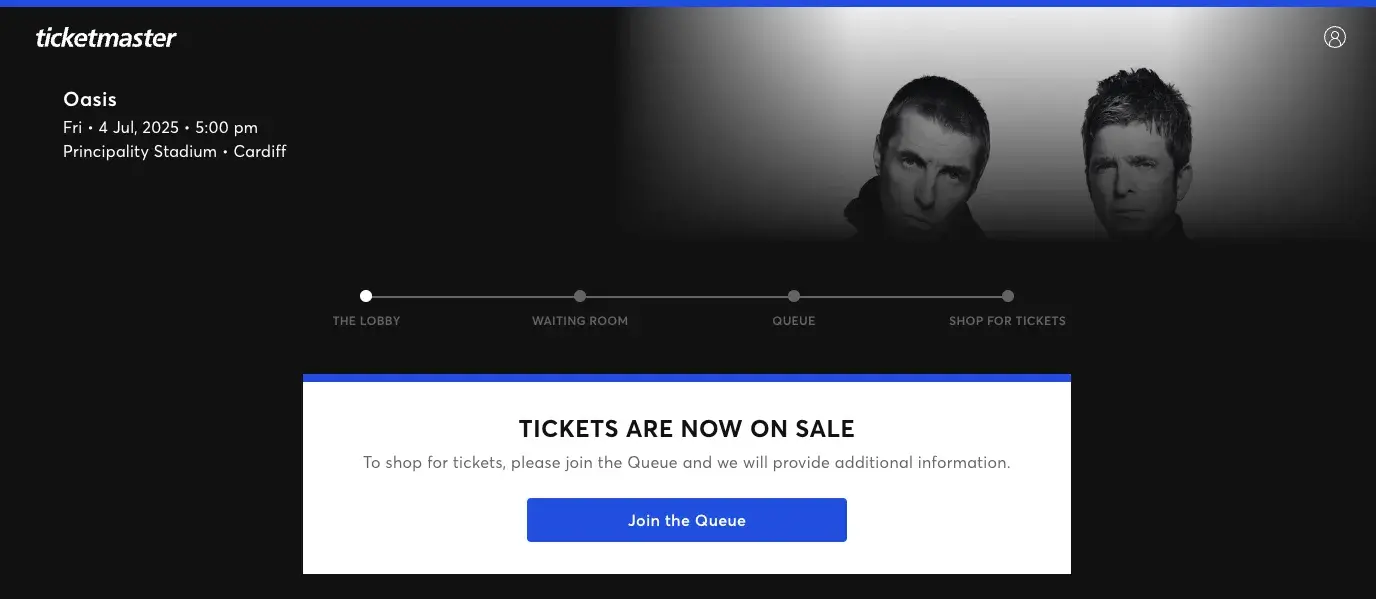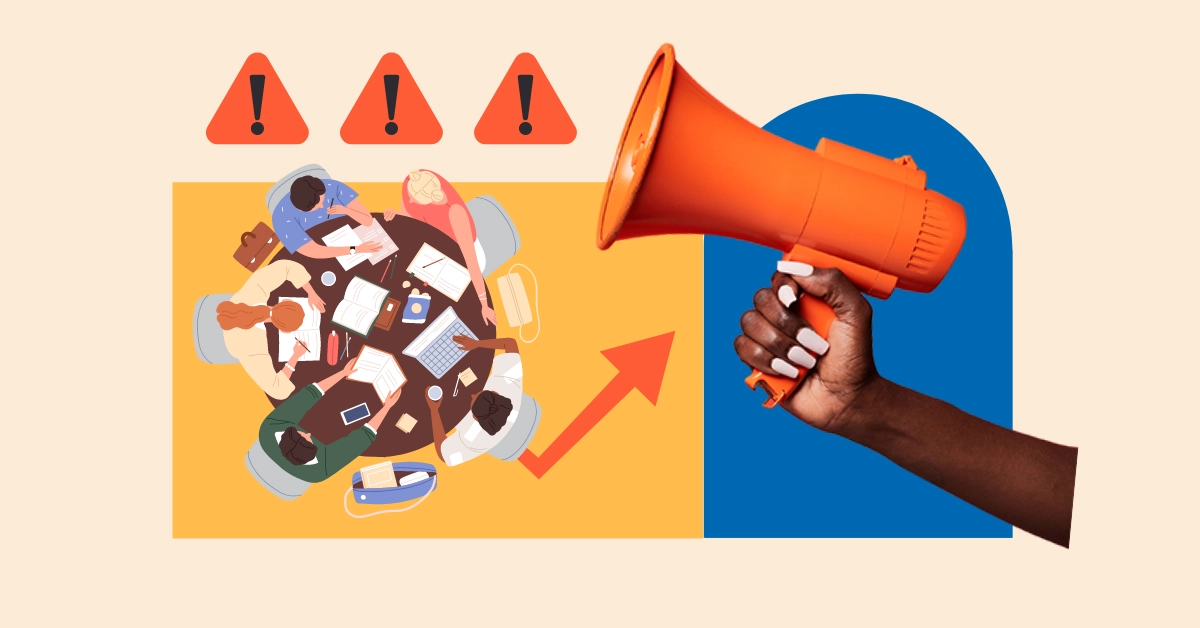In 2022, Lyft’s earning release went out with a high-profile typo in it. Volatile after-hours trading ensued, sending investors and media into a frenzy.
Instead of staying silent or sending out a curt correction, Lyft CEO David Risher took to the phones to call the media himself and set the record straight. Not only did this endear him to the public and swing the media coverage back in Lyft’s favor, but it gave him a platform to talk about Lyft’s positive financial performance that quarter.
Free Download: Crisis Management Plan & Communication Templates
Business reputation crises can come in all shapes and sizes, from strikes to hurricanes to data breaches. I’ve seen firsthand how a company’s response determines whether an incident is a small blip on a company’s record or whether it explodes into a full-fledged crisis.
Follow along as I walk you through the most common types of crises you may face, how to manage a crisis step-by-step, and examples to learn from.
Table of Contents- What Is a Business Reputation Crisis?
- Why Do Business Reputation Crises Happen?
- Can You Prevent a Business Reputation Crisis?
- How to Manage a Business Reputation Crisis
- Reputation Crisis Examples
What Is a Business Reputation Crisis?
A business reputation crisis is a loss of trust in a company caused by an event, company action, or leadership failure.
A reputation crisis can spiral quickly and usually starts with a triggering event that leads to public outcry. I’ve learned that a company’s response — or silence — to an issue has the power to mitigate or worsen a crisis.
Changing consumer preferences means that businesses face stronger pressure to respond to issues both outside and inside their company. 72% of CMOs and CCOs say that people increasingly expect immediate action on issues and crises.
Why Do Business Reputation Crises Happen?
Sometimes the public will be frustrated with your company for an action or misstep you took, and sometimes it’s due to something external. In some cases, reputation issues start with the company. Changing prices or policies, bad behavior from an employee or executive, or poor communication can lead to frustration or outrage.
Natural disasters and crime, for example, are outside of your control. How you respond to those incidents, though, determines whether your reputation will suffer.
The causes of a reputation crisis are evolving as new threats and realities emerge. In an Edelman study, executives reported which types of crises they’d faced in the past three years. Here are the top crises they faced — and what to expect.
Top Causes of a Reputation Crisis
1. Online and Social Media Attacks
For all the benefits social media brings, it means customers can air grievances in the public sphere, in real-time. That means that reputational damage can happen in mere hours online whether an allegation is true or not. Viral negative customer stories, misinformation, fake news, and trolling are now common challenges for companies.
2. Supply Chain Issues or Disruptions
In the past few years, we’ve seen countless companies have major problems with their supply chain. Empty shelves, missed orders, and cargo ships full of rotting produce are never a good look. While some supply chain issues fall outside a company’s control, they harbor the backlash and fury from customers.
3. Talent Shortages and Labor Issues
I’ve personally been impacted by slow service and delayed orders due to staffing issues, and it’s frustrating. Nearly 1 in 4 companies reported talent shortages in the past few years. Labor issues overall are top of mind for companies, with 88% worried about the impact of issues like employee and leadership turnover, strikes, employee activism, and talent shortages.
4. Diversity and Inclusion Issues
Can you imagine trying to recruit women to work at the Weinstein Company after its crisis? (It’s no longer in business!) Customers and employees want to know that a company and its leaders treat people with respect and are making strides to advance diversity, equity, and inclusion (DEI) in both its company and the community.
5. Climate Change and Sustainability Issues
Consumers — especially Gen Z — are paying closer attention to the environment and sustainability issues. While most companies won’t face a major crisis like an oil spill, many face pressure and activism to take actions like switching to recyclable materials.
7. Cybersecurity Incidents
Here’s one that’s become much more worrying in recent years. Cybersecurity incidents including data breaches, ransomware attacks, and phishing can cause business interruptions or theft of customer data. In 2024 alone, 59% of companies reported being victim to a ransomware attack.
Can You Prevent a Business Reputation Crisis?
So, what’s a company to do in the face of all these challenges? While you can’t prevent every issue (especially external ones), you can control your response to those incidents.
48% of Gen Z say that a brand’s response to issues and crises is a deal-breaker in their decision to buy from that brand or business. With a quick response, empathy, and proactive planning, you can prevent an incident from turning into a full-fledged crisis.
How to Manage a Business Reputation Crisis
To help you prepare, here are my six tips for managing a business reputation crisis before, during, and after it happens. To illustrate these steps, I’ve used a fictitious but common crisis scenario — a service outage — to show how these steps work in action.

1. Create a crisis communications plan.
The best thing a company can do to prevent and mitigate crises? Have a crisis response and communications plan in place. This document should identify a response team, messaging frameworks, and action steps to take when a crisis occurs. With a solid plan, you can respond to PR issues far more quickly and effectively.
In practice: I convened a team with key personnel from marketing, PR, IT, legal, and human resources to create a crisis response plan. Once finalized, we meet once a year to review and update the plan.
2. Practice social listening.
The last thing you want is to come into the office on a Monday morning to discover your company’s been bashed in the news or across social media all weekend.
In my time in PR, I used real-time monitoring tools like Sprout Social, Cision, and Critical Mention to identify negative coverage and comments. Set up keyword tracking for your brand name and executives so you can respond to them and de-escalate a crisis before it gains steam.
In practice: I used HubSpot Marketing Hub to monitor social media mentions. One day, I spotted an unusual number of comments saying they couldn’t log into their accounts.
3. Determine the level of crisis.
In your crisis communications plan, create an escalation framework for crisis levels to keep your response proportional to the incident. For instance, you don’t need to pull your CEO in to respond to one bad review. Rate each crisis as it starts and elevate or downgrade the crisis based on what’s happening day by day.
Here’s an example framework of how to think about and respond to different types of crises.

Download HubSpot’s Crisis Communications and Management Templates to put this into action.
In practice: After confirming with our IT team that there was, in fact an outage affecting most customers, I classified the crisis a Level 3. I communicated internally and convened a group of key responders to determine a response.
.png)
Crisis Communication and Management Kit
Manage, plan for, and communicate during your corporate crises with these crisis management plan templates.
- Free Crisis Management Plan Template
- 12 Crisis Communication Templates
- Post-Crisis Performance Grading Template
- Additional Crisis Best Management Practices
Download Free
All fields are required.
.png)
4. Choose a response method.
Next, you need to choose whether to respond and how to respond. As long as you aren’t violating any legal or regulatory boundaries, it’s almost always better to respond in some way.
Your method of response should match the escalation level and the source of questions or complaints. If most complaints have come through social media or customer service tickets, the best response is likely a social media post and an email to affected customers.
If the media has started to cover the incident, then you may need to respond through addressing the media.
“If media are reaching out and they ask a clear and direct question, they really do deserve a clear and direct answer,” said Jake Doll, director of client relations at PANBlast. “Providing them with something is an important step, and then really thinking through, are we comfortable with media sharing this narrative as they see it, or should we share a message to our customers in an email to address it for them?”
In practice: The group determined to keep the response to a brief social media statement and email to customers. We wrote several templated messages for customer service and social media to send in response to customer queries.
5. Respond with the right messaging.
It’s not just when or where you respond that matters. The language you choose has a huge impact on customer perceptions and your reputation going forward.
Research shows that customers want companies to demonstrate that they:
- Are honest (showing integrity and transparency)
- Are dependable (that they’ll keep their promises)
“An acknowledgment of an issue is what most people are hoping for. You can't fix a reputational issue or a product outage or a leadership mistake in one message, but you can say we see that this is happening and that it’s a problem,” said Doll.
While transparency is important, resist the temptation to over-share. “Releasing a statement as quickly as you can is important, but brevity is my go-to recommendation for any crisis because you don‘t want to over-explain things that may not be in the public’s awareness yet,” said Doll.
Researchers Gijs Fannes and An-Sofie Claeys found that empathy is also a key ingredient to effective crisis communications. “Organizations should explicitly show compassion and sympathy because stakeholders will only then experience reciprocal empathy towards the organization,” Fannes and Claeys wrote in Public Relations Review.
Empathy language should go beyond understanding statements like “We know this is an inconvenience,” and should instead use mental state verbs like “We sympathize with the inconvenience.”
In practice: Here’s the statement I wrote: “We became aware today of an outage affecting 40% of customers. We sympathize with your frustration and are working to restore full functionality and access as quickly as possible. For real-time updates, please visit our status page.”
6. Follow up with changes you’ve made.
What happens when you respond to a crisis with promises, but no action? “If you do not practice what you preach, stakeholders will probably find the empathic response insincere, which is detrimental to your reputation,” explained Fannes and Claeys.
Always follow a crisis with action, even if you can’t meet every demand. If you can’t fix the issue, offer compensation, a discount, or some other kind of reconciliation to earn back trust.
In practice: A week after the outage, we emailed all customers with a longer explanation about the cause of the outage and the steps we’re taking to prevent it from happening again.
Reputation Crisis Examples
Have you heard the saying about learning from others’ mistakes? It’s true. Learn from others’ failures and successes with these crisis examples.
1. Boeing Safety Issues

https://www.nbcnews.com/science/space/boeing-officials-quiet-return-starliner-spacecraft-rcna170601 In January 2024, a rear door plug expelled from a Boeing 737 Max 9 plane midflight and landed in someone’s backyard. Had a passenger been seated in that row, it could have ended in tragedy. In the week that followed, airlines grounded the 737 Max 9 plane and found loose parts on other jets. The FAA announced an audit of Boeing production and whistleblowers came forward about safety concerns, resulting in the company firing its CEO.
In another failure in September, safety issues left two astronauts stranded in space for months as there were concerns about returning on Boeing’s Starliner spacecraft.
My Analysis
Boeing has stayed mostly silent throughout the crises of 2024 due to ongoing legal investigations. In that time, media reports have dominated the headlines about the company. Whistleblower reports, speculation, and reports of investigation non-compliance have dominated the narrative and eroded trust.
After the Starliner spacecraft returned to Earth empty in September, Boeing’s spokespersons backed out of a news briefing at the last minute — leaving the public to be their judge.
2. Oasis Ticketmaster Ticket Debacle

Much like the Taylor Swift ticket debacle of 2023, Ticketmaster found itself in the hot seat again in September when demand surged for Oasis reunion tour tickets. Fans faced long waits and technical glitches before reaching a purchasing page — and then the prices were different. Seats that were originally less than £150 had jumped to £350 without warning due to surge pricing. A week later, U.K. regulators opened an investigation.
Ticketmaster did not respond to fans’ outcry during the ticket fiasco and continued posting upbeat promotional content on its social media platforms. Days later, Ticketmaster released a statement that “All ticket prices, including Platinum, In Demand, and VIP, are set by the tour.” Oasis took even longer to respond, turning the crisis into a public finger-pointing exercise.
My Analysis
Ticketmaster should have responded to fans immediately by accepting responsibility and actively giving fans recourse for technical issues, rather than blaming the musicians. The slow response and blame games further eroded trust in the brand.
3. Starbucks CEO Commute

In August 2024, Starbucks brought in a new CEO. Media and activists were quick to jump on the fact that the new CEO Brian Niccol would be commuting more than 1,000 miles to Seattle each week by private jet. Not only does that run afoul of Starbucks’ environmental commitments, but it comes at a time when Starbucks just required its employees to relocate to Seattle as a hybrid workforce and baristas want to unionize.
My Analysis
Starbucks stayed quiet during the outcry, not releasing a statement about the issue. Assuming that they would not have changed the arrangement with Niccol, this was likely a smart move. However, I would have liked to see a stronger response like United Airlines CEO Scott Kirby, who posted about a similar issue on LinkedIn and committed to only flying commercial in times of crisis.
Instead, less than two weeks later Starbucks released Niccols’ plan for revamping Starbucks and everything he wants to accomplish. While only time will tell the impact on customer and employee perceptions, I believe Starbucks effectively changed the conversation by looking to the future and pivoting toward positive change.
Turn a Crisis into Opportunity
Above all, I’ve learned that reputations can be a fragile thing. Even after years of dependability, a brand can lose a customer’s trust overnight. The good news? They can earn it back again.
Though it takes longer to gain trust than lose it, each crisis is an opportunity to be vulnerable, show empathy, and recommit to your values. If you do that, you’ll come out even stronger than before.
Want more tactical recovery steps? Visit part II of this series on business reputation recovery.
.png)
Crisis Communication and Management Kit
Manage, plan for, and communicate during your corporate crises with these crisis management plan templates.
- Free Crisis Management Plan Template
- 12 Crisis Communication Templates
- Post-Crisis Performance Grading Template
- Additional Crisis Best Management Practices
Download Free
All fields are required.
.png)



![De-Escalation Techniques: 30 Proven Strategies to Diffuse Tension and Build Trust [Expert Tips + Data]](https://www.hubspot.com/hubfs/de-escalation-techniques_2.webp)



![My Tips for Social Media Crisis Management [Free Template]](https://www.hubspot.com/hubfs/social-media-crisis-management-1-20241107-3106355.webp)


